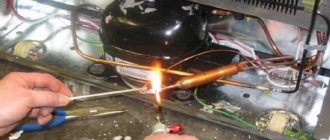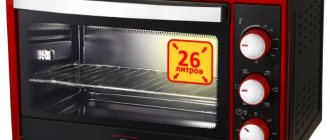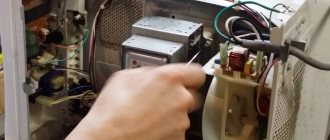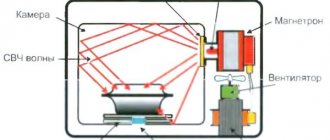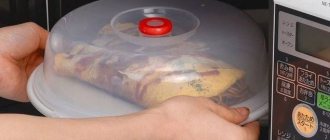Fuse design, types
Why do you need a microwave fuse? It protects electronics from voltage surges, or rather, their consequences. Instability in the network leads to a sharp surge in voltage and burnout of the electronic components of the microwave oven.
Therefore, before the current reaches the “filling” of the equipment, it passes through a flask with a metal thread. If the value in the network exceeds the nominal value, then the thread burns out, breaking the circuit and protecting the device.
The glass (ceramic) fuse bulb serves as a protective shell against splashes when the filament melts.
When a part burns out, a Samsung or Daewoo microwave may not turn on.
How many are there in a microwave oven? There are three types of protective devices:
- Network. Located on the input cable. They provide protection not only for equipment from surges in the network, but also for the entire home circuit from short circuits (short circuits). The latter often happens when one of the microwave elements malfunctions. In case of any problem, the protection disconnects the equipment from the network.
- High voltage. Why do they work? As soon as an overload occurs, the fuse breaks the circuit to ensure the safety of the magnetron and transformer - one of the main components of the microwave oven. Sometimes the machine gun on the dashboard gets knocked out. What does it look like and where is it located? It is located right next to the transformer and is enclosed in a plastic case with latches.
- Another fuse is installed on an electronically controlled microwave oven. Additionally, it serves as a converter of electrical current into a suitable voltage for electronics. Where is? The protection element is located above the primary winding of the transformer and is enclosed in insulation. Therefore, if it burns out, it is quite difficult to change it.
How to determine the type of fuse in your model? To do this, look at the instructions. High voltage products are very rare. And the point here is not in the structural features, but in the fact that not all factories install them. Most often you can find a network one.
If the high-voltage protection is burned out, everything in the microwave oven will work except heating. You can put the dish on heating, while the circle will rotate, but the food will remain cold.
If the network element burns out, then the operation of the equipment is impossible.
Causes of burnout
As mentioned above, fuses burn mainly due to a sudden surge in voltage in the household electrical network, which provokes an overload of the circuit or a short circuit in the turns of the transformer coil. These processes trigger the protection, which occurs by interrupting the contacts in the circuit and disconnecting the microwave from the network. This is necessary not only to preserve the integrity of the more important parts of the stove, but also to prevent a fire hazard in the house.
But there are times when the fuse burns out during a certain action. For example, when opening the microwave door. This situation occurs in ovens of many brands, but most often Samsung and LG models suffer from this. The problem is the door microswitches. Any microwave has three of them, and according to the safety protocol, they are triggered in turn to automatically stop the oven when the chamber is fully opened. This measure is necessary to prevent radiation from penetrating outside. And when particles of fat or carbon deposits get on the springs of the microcontacts, they weaken, which can also happen even simply from prolonged use. Because of this, the switch does not operate and the fuse burns out.
But if the protection is triggered when the microwave oven is turned on, and replacing the fuse does not help, then the problem is most likely a damaged high-voltage diode. This has often been observed with Panasonic models. This can happen when there is a short circuit in the windings of the transformer or inside the magnetron.
DIY replacement
Before replacing a part, unplug the microwave oven. Arm yourself with a Phillips screwdriver and unscrew the screws securing the casing.
Now inspect the constituent elements. What does a blown fuse look like? Upon visual inspection, it will be swollen or black marks of burns will be visible.
If the flask is glass, you may see a broken thread inside. If the circuit is short-circuited, the breakdown is more difficult to detect. To do this, tests are carried out with a multimeter in resistance mode:
- Attach the probes to the contacts of the device.
- Everything is fine if the screen shows zero.
- If it displays a value other than zero or “OL”, the part has burned out and needs to be replaced.
For repairs you will need identical elements. They must have the same dimensions and current range. Usually these indicators are indicated on the case. You can view them through a magnifying glass.
Important! Do not install a new fuse with bare hands. Use pliers or rubber gloves. Some microwave parts retain voltage even when unplugged.
After installation, reassemble the device in reverse order. When you turn it on, make sure all elements are working.
You should not carry out repairs yourself if you have not done this before. Ignorance of the microwave device can lead not only to complete breakdown, but also to electric shock.
Replacing the fuse
Replacing a blown fuse is usually not difficult (except in some cases with control module protection). But getting to it and performing some actions related to safety for health and life may seem like a problem for inexperienced craftsmen.
Disassembling the microwave
It's actually simple:
- unplug the oven power cord from the socket;
- find all the bolts on the back cover and unscrew them;
- remove the casing;
- we are working on fuses, but without haste, since if you need to inspect the magnetron, you will have to remove the transformer and air duct.
Advice! To work safely with fuses, it is necessary to perform one more operation - discharge the capacitor.
Capacitor discharge
The electrical circuit of the microwave contains a resistor that automatically discharges the capacitor when the device is disconnected from the network. In fact, it may be absent, or if it is available, it may not function. It is strongly not recommended to ignore these precautions and carry out work inside the oven with bare hands, since even when the power is turned off, the capacitor retains the accumulated voltage (and not a small one). And only if you are completely sure that it is discharged can you safely carry out repairs.
Important! Disconnecting the microwave from the power supply does not guarantee complete safety during repairs. Many parts inside retain residual stress for a long time. Electric shock can be not only painful, but sometimes fatal!
There are enough recommendations on how to discharge a capacitor. It is generally advised to close the contacts using a screwdriver. But this method is not approved by professionals: sparks and even failure of the capacitor are possible, not to mention a melted screwdriver. Experts suggest using a separate resistor with a resistance of 20 ohms. Or you can remove the discharge using a regular light bulb.
Replacing the fuse
Even when the capacitor is guaranteed to be discharged, it is not advisable to change the fuse with bare hands. You need to use current-insulated tweezers or a screwdriver with a well-insulated handle. The replacement algorithm is as follows:
- make sure that the device is disconnected from the network;
- Using a tool, remove the fuse that has burned out from the socket;
- install a new one;
- We assemble the stove and check its functionality.
As you can see, it only takes a few seconds to replace a part. More time is spent on preparation and compliance with safety measures. And to be completely sure, you can watch the training video.
Circuit breakers
A fuse is an element of protection for an electrical circuit. Nowadays, almost all electrical devices are equipped with such elements and microwave ovens are no exception. There are many types of fuses, differing from each other in the operating principle, and one of them is a fuse link. For electrical protection, this type of fuse is used in microwave ovens - a fuse. The operating principle of the fuse is based on the metallurgical effect. Such a fuse in its design contains a thread made of a low-melting material - metal. If the permissible current flowing through this thread is exceeded, the thread heats up to the melting temperature of the metal from which it is made and is destroyed. In this case, the electrical circuit is broken and the device is de-energized. The permissible amount of current that the thread can pass through itself without destruction directly depends on its cross-section and the properties of the material of manufacture. To protect adjacent structural elements of electrical equipment from splashes of molten metal formed when the filament breaks, the filament is placed in a glass or ceramic tube. And, for ease of installation, metal caps are put on this tube at the ends, which are fuse contacts. This is exactly how we are used to seeing a fuse today, in the form of a tube with shiny caps.
Read also: Stator for a circular saw
The design of a microwave oven most often contains three fuses. Figure 1 shows one of the options for the location of fuses inside the furnace.
- Mains fuse. It is located, as a rule, on the network filter board, schematically - at the furnace power input. Through this fuse, all circuits of the device are powered. The protective actions of any fuse are bidirectional. It’s the same with the mains fuse: on the one hand, it protects the furnace itself from power surges, and on the other, it protects the supply network from short circuits that can occur when various types of malfunctions occur in the furnace design. Having a fairly large rating - 8 - 12A, the mains fuse weakly protects the oven electronics from voltage surges, but does a good job of protecting the network from microwave malfunctions.
- High-voltage fuse – is an element of protection of the high-voltage power supply circuit of the magnetron. It protects, first of all, the high-voltage transformer from overloads that occur in the event of failure of the elements of the multiplier or the magnetron itself. Structurally, the high-voltage fuse is located next to the transformer, and schematically, it is included in the open circuit, between the output of the high-voltage winding and the input of the multiplier. High voltage circuits have special safety requirements. Therefore, the conductors of this circuit have reinforced double insulation, and the fuse is hidden in a special plastic casing. Housings can have different designs and shapes. But, they almost always consist of two halves, connected to each other by a plastic jumper on one side and latches on the other. If you disconnect the latches, the casing opens like a box, providing access to the fuse itself (Figures 2,3,4).
There are furnace models in which there is no high-voltage fuse as such - it is not provided by the manufacturer. In such cases, the function of protecting the high-voltage circuit is performed by the mains fuse. In order for the mains fuse to trip when the elements of the magnetron power circuit fail, the load on the transformer must more than double and for a fairly long period of time, which clearly has a bad effect on its health and can lead to failure of the transformer.
- The presence of a third fuse is typical only for furnaces with an electronic control panel. Each electronic panel is powered by its own separate power source. The basis of such a source is a low-power power transformer, which converts the network voltage into voltages suitable for powering the panel circuits. The primary winding of this transformer is powered from the network through a separate fuse, which is structurally, most often, an element of the design of the transformer itself. In other words, this fuse is located on top of the primary winding and is covered with insulation on top. This arrangement makes it much more difficult to replace the fuse if it fails. But it often happens differently, for example, in Samsung ovens, this fuse is located separately on the control panel board and replacing it, if necessary, is not difficult. This fuse has a very small rating and is very sensitive to voltage instability in the network.
When the high-voltage fuse trips, the oven will “pretend to be working”, everything will function except the magnetron, that is, everything will make noise, burn and spin, but it will not heat. But when the mains fuse or the control panel fuse trips, the effect will be approximately the same - the oven will be completely silent.
Life teaches you not to skimp on safety, so if any of the fuses blows, it is always better to look at its rating on the cap and replace it with the same one. But, if you still decide to install the “beetle”, then I beg you, do not under any circumstances use nails or other conductive objects that are suitable in size for this, and do not do it as shown in Figure 5 on the left - this is not it won't lead to anything good. Don’t be lazy, use the table for calculations, and do it as shown in Figure 5 on the right, believe me, it will be better.
Read also: Copper-phosphorus solder for copper soldering
| Filament destruction current, A | Wire diameter, mm | |||
| Copper | Iron | Tin | Lead | |
| 0,5 | 0,03 | 0,06 | 0,11 | 0,13 |
| 1,0 | 0,05 | 0,12 | 0,18 | 0,21 |
| 2,0 | 0,09 | 0,19 | 0,29 | 0,33 |
| 3,0 | 0,11 | 0,25 | 0,38 | 0,43 |
| 4,0 | 0,14 | 0,3 | 0,48 | 0,52 |
| 5,0 | 0,16 | 0,35 | 0,53 | 0,6 |
| 6,0 | 0,18 | 0,4 | 0,6 | 0,68 |
| 7,0 | 0,2 | 0,45 | 0,66 | 0,75 |
| 8,0 | 0,22 | 0,48 | 0,73 | 0,82 |
| 9,0 | 0,24 | 0,52 | 0,78 | 0,89 |
| 10 | 0,25 | 0,55 | 0,85 | 0,95 |
| 15 | 0,32 | 0,72 | 1,12 | 1,25 |
| 20 | 0,41 | 0,87 | 1,35 | 1,52 |
| 25 | 0,46 | 1,0 | 1,56 | 1,75 |
| 30 | 0,52 | 1,15 | 1,77 | 1,98 |
The table, according to approximate calculations, shows the physical parameters of the threads of homemade fuses made from various materials. This is not an example of how to do it, but a fuse restored using the data in this table is still better and safer than a nail.
Electricity is a good thing, but every double-edged sword, remember this. When repairing electrical devices, be careful, follow safety precautions and do not neglect the safety features. Good luck with the renovation!
This household appliance is an indispensable assistant for the housewife in the kitchen: with the help of a microwave you can quickly heat up food prepared the day before, as well as stew vegetables and meat products, make original hot sandwiches and much more. Like all appliances, a stove can break down; the most common fault is a fuse blowing due to a power surge. We will tell you in detail what kind of fuses there are in a microwave oven, and also provide a replacement algorithm.
Tags: Samsung microwave, microwave repair, microwave fuse
Comments 69
I disassembled and threw away the microwave in the same way. I only left the transformer from it, I’ll probably do resistance welding.
Well done of course! But! if it burns out again, be sure to remove the middle door mic, I probably saw them inside when I removed the panel, 3 of them, two with two wires, and one with three, here is the one with three, you can take it apart and look, usually there is carbon deposits on the contacts inside it
it was possible to solder 1 thin wire to a relative and then the repair would be completely free

